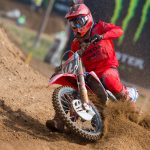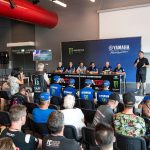My first Grand Prix was the opening round of the 2001 FIM World Championship in Spain, at the Bellpuig circuit an hour west of Barcelona. Jamie Dobb, Mickael Pichon, Fred Bolley, Pit Beirer, Stefan Everts and Joel Smets were title favourites across the 125, 250 and 500cc divisions for the first proper ‘triple class’ series to feature just one moto per class. An unbroken run of 243 consecutive events across fifteen seasons lasted until the second date of 2016 – the Grand Prix of Thailand – and produced some forceful memories and stories. Here is a selection…
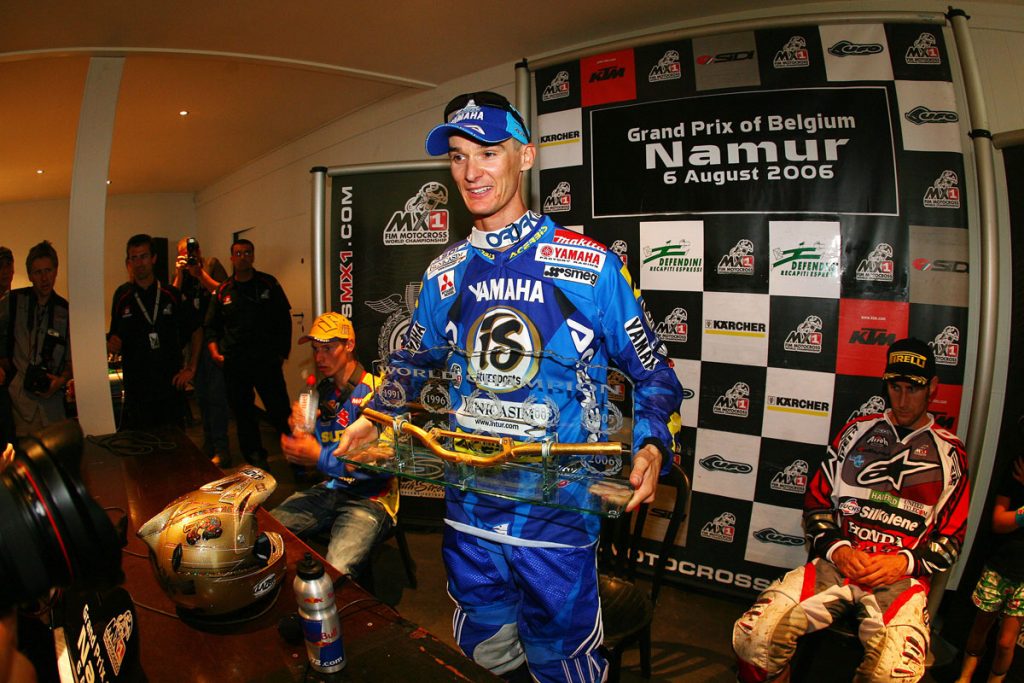
The sights of 72
The ultimate record-holder and a man who won a world championship every season and 50 of his 101 Grands Prix from 2001-2006. Stefan Everts crested the sport and is arguably the biggest name in motocross to emerge from this continent; fittingly he created some outstanding sporting moments in that six-year phase. His pure supremacy at Matterley Basin and the 2006 Motocross of Nations for what was his final professional race appearance (where he also produced a healthy shock by popping out from behind a press conference screen to announce his defection to KTM as a team manager and test/development rider) was the perfect send-off. But before the UK there was the unforgettable afternoon at Ernee in September 2003 where he won 125, MXGP and 650 motos all in one day for a Grand Prix clean sweep. Everts’ feat rounded-off a season where he’d claimed nine rounds of the MXGP class (renamed from 250cc, would become ‘MX1’ and then return to ‘MXGP’ in 2014) and seven of the 125 (which would become ‘MX2’) to classify 2nd to countryman Steve Ramon in that contest: the last time that Belgium would rule every division (Smets had the 650s). Fast forward three years and Everts – in full white get-up and golden wheel rims – would glide down the same Ernee hillside, victorious again to conclude his Grand Prix career just two weeks before that Matterley swansong.
There are some other, less celebratory, sights. In that 2006 term Everts was denied the ‘perfect season’ by a vibrant performance from Josh Coppins at Desertmartin in Northern Ireland. The Yamaha man had aced all twelve grands prix to that point and accumulated 22 motos in a row by owning the first race in the shallow Irish sand. Coppins took the second sprint however after a close pursuit, just one week after Everts had wrapped his tenth world championship and was clearly fatigued with the commitments that accompanied his success.

Stefan was also at the centre of a truly remarkable affair at the 2004 closer, the South African Grand Prix, in the temporary build of the Sun City leisure complex. As world champion he was seen as the instigator of the riders’ strike against the eradication of prize money for 2005 when the field refused to leave the waiting zone and delayed the start of the first moto by ten minutes. His clash and crash with principle rival Mickael Pichon on the first lap of the second moto then led to momentary madness as he walked to the adjacent corner and threw his goggles at the circulating Frenchman. Everts returned, remounted and hovered on track until Pichon and the leaders approached to lap him and tried to block the Honda rider.
I can remember trying to keep pace and gather some quotes from a serious and pale-faced Belgian as he hotfooted from the FIM Stewards office to his car to start the trip back to Johannesburg airport. He carried a mix of worry and anger over already-mounting rumours that he’d face a ban for 2005 due to the ‘industrial’ action and then the Pichon prang. “Pichon made a really aggressive move on me which I also thought was really dangerous and I was so furious with him that as he came around for the next lap I threw my goggles at him. I know this was wrong and I should not have reacted like I did. Unfortunately, it happened and I cannot turn back time. I have been to the jury meeting and I made an apology for what I did.” That was all I could get out of him. Before the Motocross of Nations at Lierop both riders issued a public apology for the spat and Everts was fined 10,000 euros and given a two-year suspended sentence. Even legends can veer off the mark sometimes.
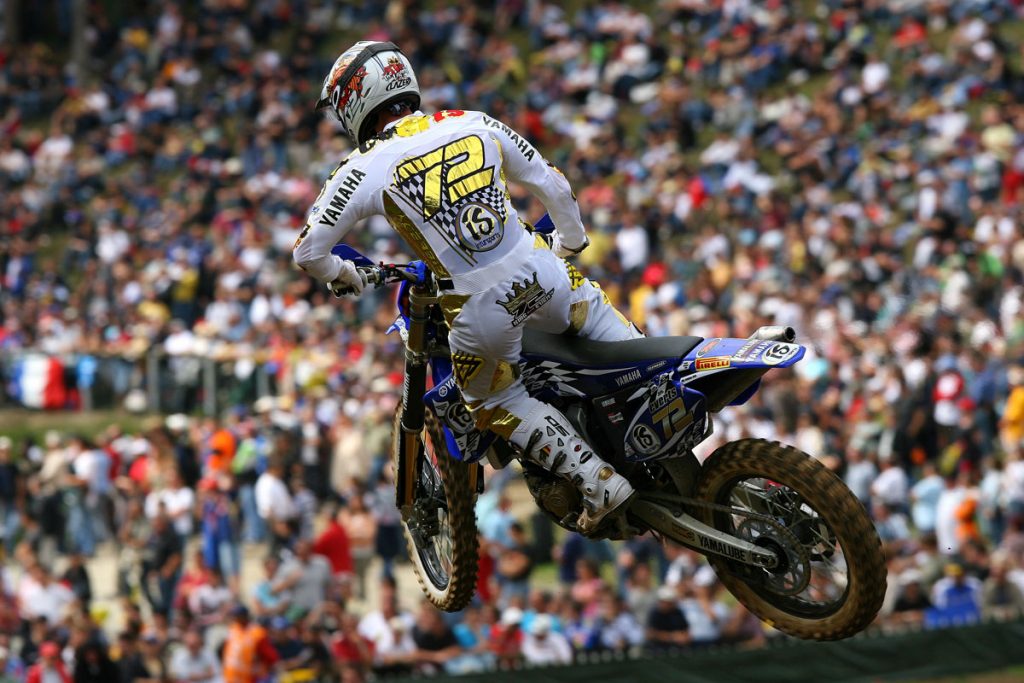
For me the best Everts sight is not the time he moved father Harry to tears by winning the 500cc championship at a wet in Austria in 2001 and becoming only the second ‘Mr 875’ but his 2006 title confirmation in August of that year. He created an emotional – almost storybook – situation at Namur by sealing the tenth crown on home turf and arguably the most atmospheric and historic of motocross tracks. The champagne finish-line festivity of what was his 99th triumph has not been matched since. “As soon as I arrived on the Citadelle the tears came up,” he said at the time and on a weekend where he actually watched Harry race again thanks to a Veteran’s contest. “The best day of my life was watching the birth of my child [son Liam] and nothing will ever beat that…but this is in the top three for sure. I never dared to dream of being World Champion in Namur.”
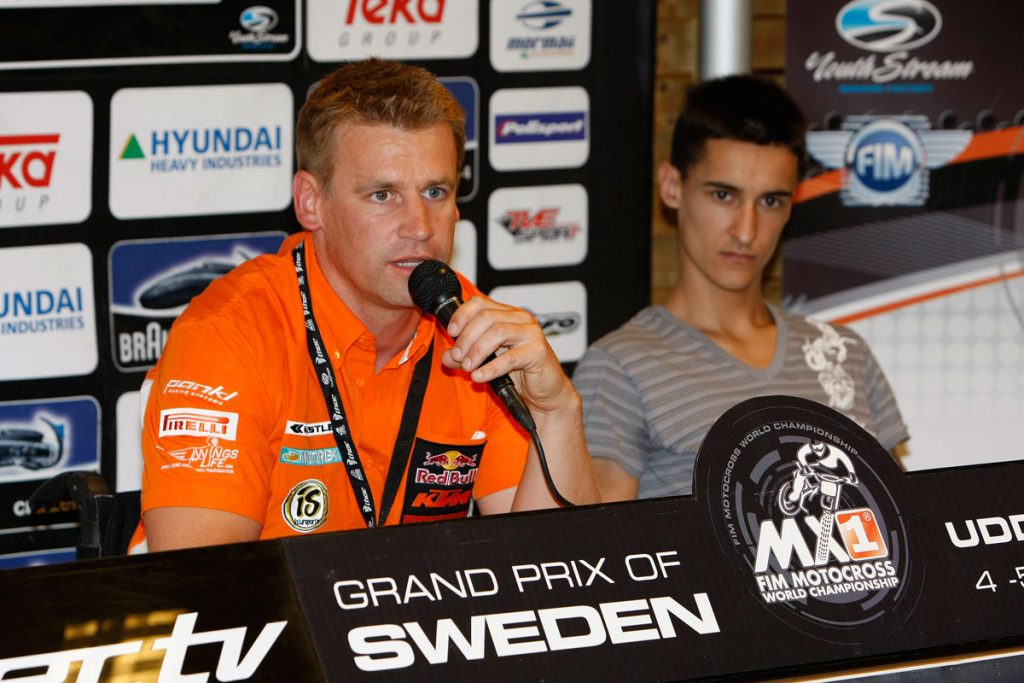
Musquin makes his plea
There have been some outstanding press conferences over the years. Youthstream President Giuseppe Luongo’s rant at the Bastogne for the 2012 Grand Prix of Belgium against the perceived negativity surrounding the sport was an extended outpouring of unscripted frustration. There was also Joel Smets’ scarily calm exposition while holding the microphone for the 2004 Grand Prix of Germany press call: the factory Suzuki rider ignored the question from press officer Pascal Haudiquert and threatened to take a can of gasoline and burn down the noisy beer tent that was preventing the riders from getting any rest. It was worryingly entertaining (for the record, Smets decided against vandalism and instead departed the Talkessel circuit and parked his camper in the nearby hamlet of Teutschenthal, reporting that he gained a much better night’s sleep).
Perhaps the winner though is the conference called by KTM at the 2009 Grand Prix of Sweden. In the new but small media office at Uddevalla, Pit Beirer sat with Marvin Musquin; the Frenchman then only blessed with a passable level of English and embarked on an explanation as to why the Red Bull crew had signed the MX2 championship leader from the privateer cash-strapped NGS team.
First, some context. Musquin, a protagonist of the French SX Tour series and scorer of some noteworthy top ten results in 2008 with NGS in the first of a two-season agreement, had started 2009 in fine form with a podium and victory in the first two rounds. By the sixth Grand Prix at Catalunya and after a torrid day in which he’d finished 11th overall amid rumours he was yet to be paid by the small French Honda crew and their working relationship had broken down, Musquin – accompanied by ever-present coach Yannick Kervella – left NGS to be picked up by KTM who plugged the 20 year old into the squad that had lost main rider Shaun Simpson to a broken leg.
Musquin was leading the MX2 championship – the first time ever for Honda – and went on to dominate the next two rounds in Britain and France and won six of eight motos with the KTM. NGS and Honda launched a court case in France that would carry heavy financial penalties for Musquin if he attempted to race in Sweden for round eleven of fifteen. After initially contemplating an undesirable, messy and brief return to Honda for Uddevalla (that was followed by a three-week summer break in which the dispute could have been settled) Musquin elected not to compete with other administration hassles tied-up with his licence and entry through KTM. Youthstream’s Giuseppe Luongo first addressed the media to explain that the promoters were not in a position to arbitrate over contracts between manufacturers and riders and would not exclude Musquin from the Grand Prix despite the mess. “How can we turn away the leader of the championship? Contracts can be a crazy world, some riders can win GPs and be paid nothing and the other way around,” he said.
Looking somewhat solemn, Musquin then sat next to Beirer and both parties gave their version of events. Beirer, who had faced a financial mess with the Vismara Honda team in 2002, then began a partially veiled tirade against the manufacturer for their varying degrees of support in the paddock and the interest they have in race teams and riders. It was a ballsy and profane rant against another brand as Beirer barely contained his anger.
The Musquin matter was a complicated and rare scenario. KTM were in the distant aftermath of a notorious 2006 season where their attempt to field the dream team of Mickael Pichon and Seb Tortelli failed, and they were perceived to be throwing cash to acquire success (they subsequently worked very hard on their 450 SX-F in the following years). Their contract with Musquin was fine opportunism and would begin a union that endures to this day but, in the public’s perception, there was a hint of buying the MX2 red plate. Beirer had claimed he was talking with Musquin for 2010 long before the rider’s split with NGS.
Honda said they had made a substantial and improved contract offer to Musquin towards the end of the summer in 2008 but were turned down. Naturally, by the time of the court case they offered support to NGS team manager Bruno Losito and had a vested interest in Musquin reverting back to the CRF250R but clearly the situation could have been better managed. Losito admitted he had not paid Musquin because he couldn’t afford to.
Musquin, who had totalled 371 points, 184 of those with Honda, looked abject and troubled. His margin at the top of the MX2 table would tumble from 49 points to just 13 after Sweden. He would be spotted practicing at Lommel in Belgium on a stock KTM in the following weeks until the Austrians settled the matter out of court and he assumed his saddle on the Red Bull 250 SX-F. He would win 5 of the next 8 motos and the world championship at the final round in Brazil; perhaps the most controversial title this century. In 2010 the clouds had dispersed, and Musquin thrived: eight wins and eleven podiums saw him resist the green shoots of Roczen, Herlings and co before the USA beckoned.
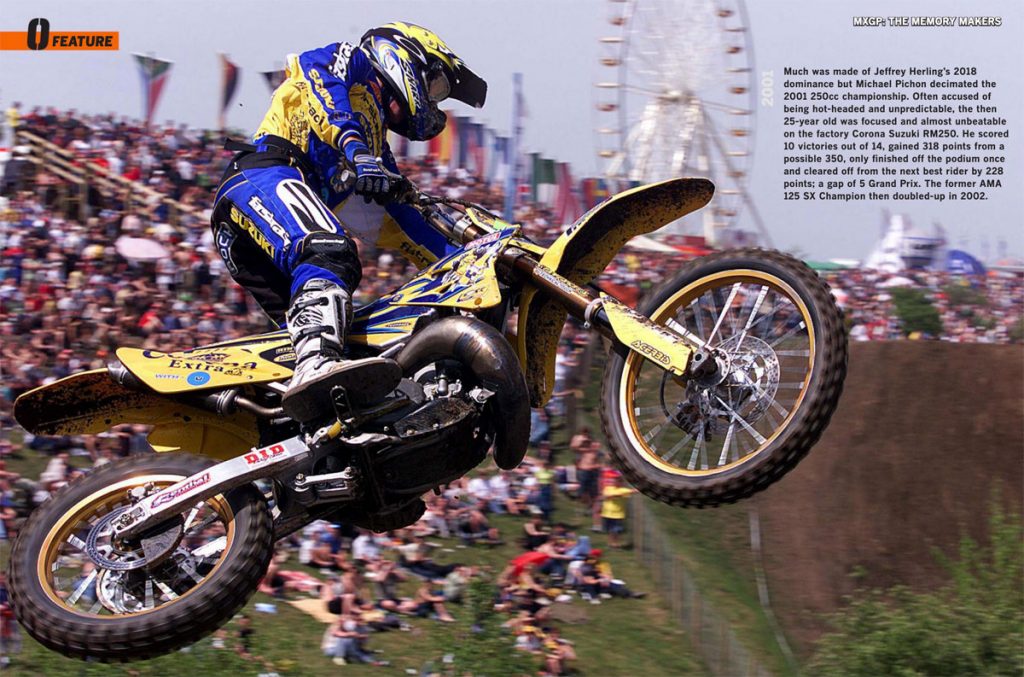
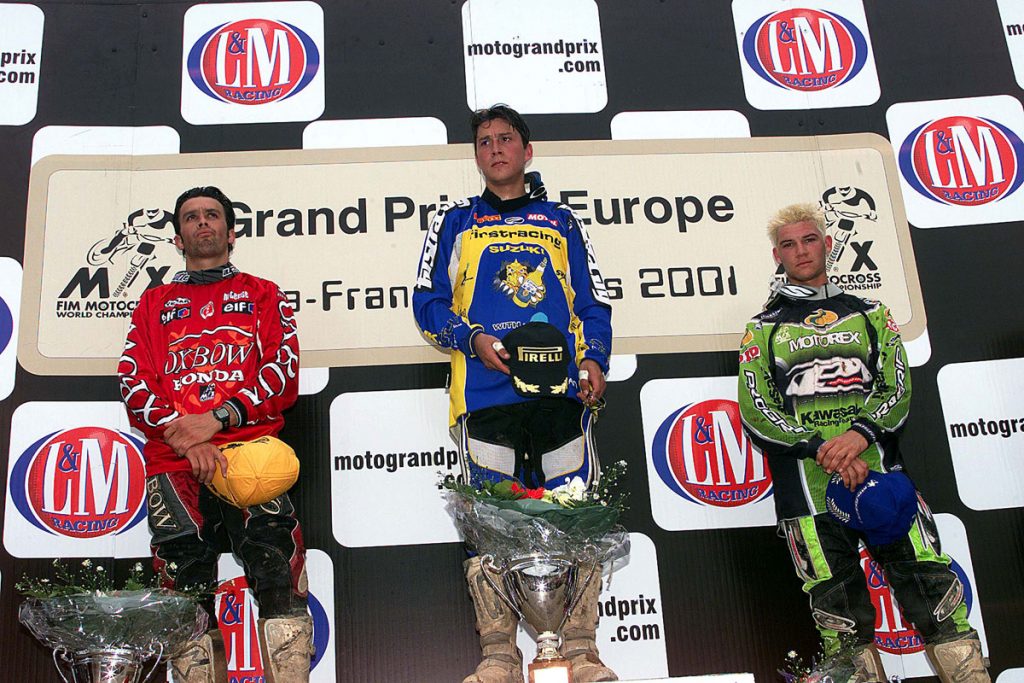
Reed’s first…and last
Chad Reed tasted European soil figuratively and literally thanks to the French stones at St Jean D’Angely at the 2000 Motocross of Nations but it was in 2001 that he moved away from Australia for his first international racing season and the initial significant chapter of a stunning career. Representing something of a gamble for Jan de Groot’s factory Kawasaki team and as a 19-year old rookie in a fast 250cc FIM World Championship field, Reed slowly built his confidence and showed his technique and versatility as the season wore on.
By the time of the twelfth round of fourteen he’d totalled enough points to sit fourth in a series already won by Suzuki’s Michael Pichon (eight wins to that point) with Honda’s Gordon Crockard (twice) and Yamaha’s Claudio Federici being the only other victors that campaign of one-moto per class. The points were closely grouped. Reed had picked up his first podium around the excellent course at Spa Francorchamps (an event promoted by the late Georges Jobe and a track sadly never re-used) and would obtain six in a row in the final part of the 2001 when he pushed ahead of the injured Mickael Maschio as the lead Kawasaki rider. “It’s such a bonus being over here and I’d be lying if I said I didn’t want to win – I believe that I can,” an already forthright Reed told me outside of his small camper in the Spa paddock. “A top five finish in the championship in my first year would be amazing and I don’t think it would be impossible. I’m making progress all the time.”
Reed was already acquainted with Dutch sand as the rain fell for a grim late summer affair at Lierop. He acclimatised himself with the sapping surface close to the German border and was 10th in qualification but on Sunday he profited from a moment of fatigue by the imperious Pichon. Riding goggle-less and with the world champion closing fast thanks to a second wind, Reed held on to win, surrounded by noisy appreciation from the damp crowd. “’I had a problem with my goggles early on and they kept fogging-up so I threw them away and that made it a little difficult to keep with Mickael,” the Aussie said after the race. “When I passed him I kept telling myself that I could go on a win this, then approaching the last lap I knew I had it in the bag and gave it all I had for those last minutes to make sure. To actually win a World Championship round before I head to the US next year has been part of my dream and what I have worked so hard for this season.”
Reed had already announced his Yamaha deal for Supercross in 2002 despite the keen advances of De Groot and Kawasaki that firmly believed their star could be a 250cc title contender the following season. As he had said in Spa, Reed’s agenda for America had been firmly set. “I got to a stage where my SX was of a decent level and my MX needed some brushing up so my decision to move to Europe was also based on a need to develop more fully as a dirt rider,” he remarked.
“Now I have a factory bike, which is also an ambition achieved, and a real chance to get Chad Reed on the map, maybe even make an impression and contacts within Kawasaki for the US. I can’t stress how stoked I am with my situation.”
“This stage of my career is a stepping-stone for me,” he added. “I’m not saying that the European scene isn’t any good, but the US is the road ahead purely because they have Supercross. I think the technical elements [of SX] are really challenging and separate the guys with the skill for it and those who are maybe just aggressive or have a fast motorcycle. You can’t slack off for a second and not only to do you need technical skills to be fast in sections like the whoops but your timing has to be spot on. I really like it and it’s the kind of off-road riding I grew up with, it requires total commitment to be successful and not everybody can do it.”
Lierop was part of a six podium run that eventually pushed him up to the position of championship runner-up, sealed in the last laps of the season in Austria and to the fury of Crockard who had held the position since April and was narrowly nudged to third by just two points. The Karntenring would not be Chad Reed’s final Grand Prix appearance. An ill-timed return for the 2016 British Grand Prix saw him place 13th overall with a best moto result of 14th.
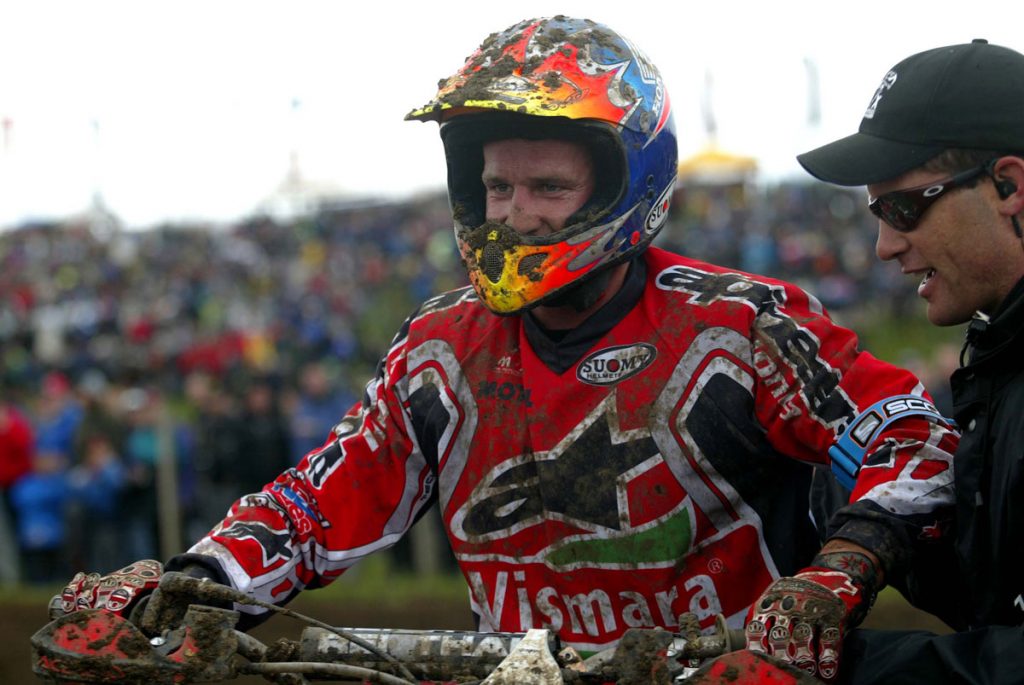
Beirer’s final trophy before the second chapter
Tenacity, courage and (often) utter conviction were hallmarks of Pit Beirer’s Grand Prix career and the German star used these traits at the helm of KTM’s racing department after taking over the role previously held by fellow former motocrosser Kurt Nicoll. The 47-year old has crafted and appeared in many championship and race-winning celebrations across a wide span of motorcycle racing disciplines since taking his place almost fifteen years ago and seventeen years after his accident at the 2003 Grand Prix of Bulgaria changed his life.

While Beirer – 1999 250cc runner-up – was part of a small group angling for the top three of the 250cc FIM world championship in 2001 with Yamaha (he eventually classified 5th) he was more competitive in 2002 with Honda. Beirer’s teammate that year in the dysfunctional Vismara squad was Josh Coppins and both clashed in races, notably Bulgaria [the very first Grand Prix run at the fateful Sevlievo facility] and Italy. The ‘Pitbull’, always so distinctive on track for his attacking style and that dayglo helmet peak, toasted his last win across the slope of Roggenburg in Switzerland in 2000 but his final spray of champagne materialised in front of his fans at Gaildorf for the tenth round of twelve in ’02. He took 2nd position to double world champion Mickael Pichon that day and after freak accidents to Chicco Chiodi (who chewed the old green trackside mesh fencing) and Johnny Aubert (who broke his rear shock, continued to ride and crashed heavily). The result was part of a season-long campaign that helped snare his fifth career top-three championship ranking, and he also claimed the German series before inking his KTM contract that winter to steer the factory’s relatively new and raw 250 SX. He would capture a best result of 5th in 2003 around Montevarchi in Italy before travelling to Bulgaria for the sixth round of twelve.
Gaildorf would provide another interesting footnote for German fans. Red Bull KTM’s Ken Roczen wrapped his MX2 title at the circuit in 2011; still the last time MXGP has visited the small venue and the last time a German has laid hands on a world championship.
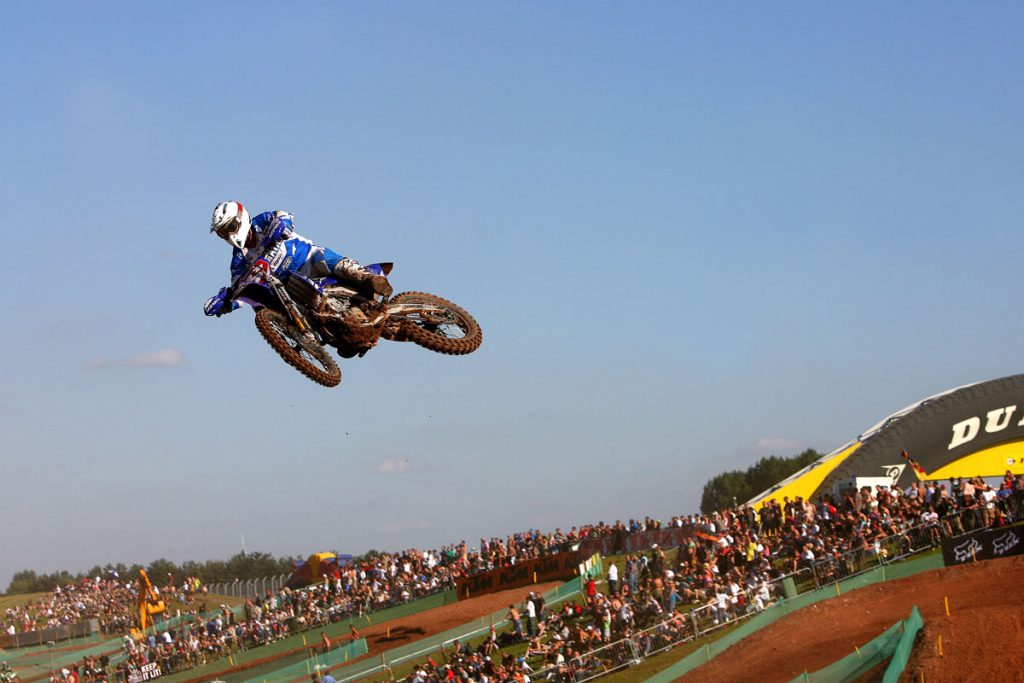
Coppins’ one armed-retreat
2007. A warm day in the UK at the end of August. Donington Park is sampling its first taste of Grand Prix motocross with an ambitious track design on the infield adjacent to Goddards, the final corner of the road racing layout. It is the fourteenth race of fifteen on the calendar.
Walking though the paddock back to the media centre I’m overtake by factory Yamaha rider Josh Coppins motoring past on the distinctive blue factory machine, his left arm slumped off the handlebar and body language as depressed as his faltering world championship bid.
The 30-year old New Zealander had just scored 14th in the first moto after taking the holeshot but his demeanour suggested the game was over.
The sight was a total contrast to the joy and jubilation at the start of the season. Coppins, signed by Yamaha to replace the retired Stefan Everts, began the campaign with a superior vein of form that the Belgian would have admired. The title favourite racked five victories and nine podiums, and approaching the Grand Prix of Czech Republic at Loket (round eleven) had a 107 point gap with 250 remaining. He’d led the championship from the first flurry of action at Valkenswaard in the Netherlands and would stay at the top until Donington Park: fronting the premier class by more than twice the number of laps compared to anybody else.
At a dark and wet Loket the dream for the luckless Kiwi GP stalwart came to a crunching end. Coppins descended the notorious steep step-down in the second moto but found out his rear brake had failed when he needed to get set for the hairpin corner at the bottom. The hefty thud into the dirt wall caused a two-inch fracture in his shoulder. Coppins – who had bizarrely suffered a DNF in the first moto because of a stone jammed into the braking system – left the Czech Republic with a 77-point advantage over Suzuki’s Steve Ramon and just 200 to go. Ramon, a placid and uncombative rider but smooth, fast and ever-present, started to chip away as a desperate Coppins experimented with several forms of treatment across a period of three-and-a-half weeks to be in a position to race, gain points and resuscitate his bid.

At Donington Park Coppins valiantly tried to compete but was in pain and powerless. He managed just one lap of the second moto. Ramon, who was nursing a troublesome left wrist tendon, was 4th overall and assumed control by 14 points. Disconsolate, Coppins packed up and departed the East Midlands venue and also left behind his life’s ambition. The following week Ramon rode to 3rd at Lierop in Holland to confirm the crown by 33 points as teammate Kevin Strijbos jumped to 2nd in the standings over the beleaguered Coppins. Ramon owned 2007 without a Grand Prix win (just two moto chequered flags and six podiums). Recognition for the Belgian seemed to be equalled if not outstripped by sympathy for Coppins. To-date his Lierop success is still Suzuki’s (and Belgium’s) last FIM World Championship. “It has been a strange season,” he said in Holland. “I have had some bad results but I also know that it is important to fight for every point. It has not been my best year but I’m still the champion.”
“I just could not deal with the pain,” Coppins said of his moment of truth at Donington. “I kept telling the doctor to give me more [painkillers] but I had reached a limit. I was struggling for concentration and at one point I could not even lift my arm to put it on the handlebars or put on my goggles.” Speaking through the phone on Sunday at Lierop, Coppins had clearly tried to put a mental block on what would turn out to be his best chance to be world #1. “Now I just need to move on,” he said.
Donington Park 2007 – home of the 2008 Motocross of Nations – was not only notable for Josh’s disappointment but also for the passing of the baton in the premier class…
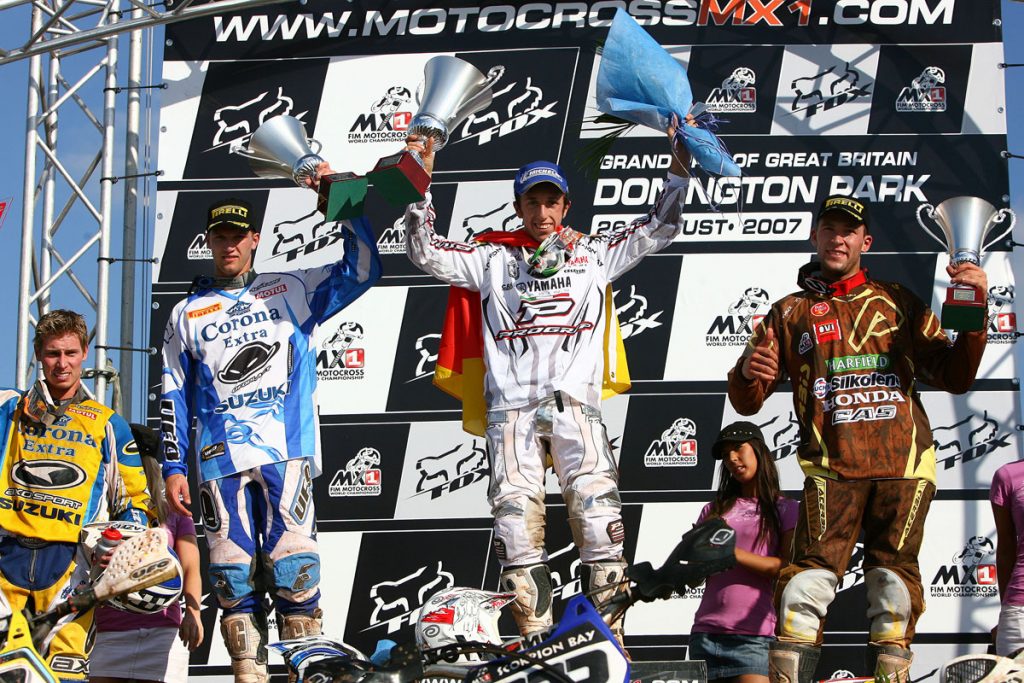
The arrival of Cairoli
Having aced the 2007 MX2 FIM World Championship (his second in three seasons) with three rounds to go, Tony Cairoli was a surprise wild-card entrant to the MX1 contest in the UK. Yamaha were keen to bolster their numbers to assist Coppins’ plight against the Suzukis and there was a healthy degree of curiosity as to how the slight Sicilian would handle the bigger motorcycle compared to the usual level of flamboyance and confidence on the 250. The production 450s had only become a reference for the premier class from 2004 with fuel injection arriving in 2005 and 2006. Compared to the compact and lithe machines of today, the bikes then were heavy, hard and often unbearably powerful.
Cairoli raced a stock YZ450F although there were rumours – unconfirmed by Claudio De Carli’s team at the time – that his motor had been heavily detuned. 12th in qualification hid Cairoli’s potential for Sunday where finishes of 2-1 heralded a sample taste of what was to come and further cemented his status as the most naturally talented and exciting rider in Grand Prix. “I know that my physical condition is good and in the second moto I was again at the front and just did what I normally do in MX2,” he said after the surprise triumph. “I did not waste any energy in the first part of the race and pushed when I needed to in order to take the win. I had two different kinds of races today. I found the power the biggest difference with the 450; for one race it is fine but for the whole season it would be hard. I prefer my 250 because I really enjoy that bike and have so much fun.”
A week later at Lierop and Cairoli would go 1-1 back in MX2 and on his favoured YZ250F. Donington Park did not instigate the beginning of #222’s premier class ascension, however. Wearing arguably one of the best race liveries in modern day Grand Prix (Red Bull-injected Yamaha blue) he was part of a three-way title dispute for 2008 MX2 gold until his first serious career injury when a snapped left knee joint occurred at the South African Grand Prix at Nelspruit. Cairoli missed five rounds. His last MX2 victory had been at Uddevalla in Sweden, the race before the trip to the southern hemisphere. Waving goodbye to the 250, Cairoli moved into MX1 for 2009 with a carefully crafted non-works YZ450F. He won by round three in Turkey and would go on to beat KTM’s Max Nagl for the championship, the first of six in a row.
2009 was also the summer of Yamaha’s ‘Decca Records/Beatles’ moment. Mainly forced by budget restrictions as a consequence of the global financial crisis, Yamaha Motor Europe could not offer De Carli’s Yamaha team further support for 2010, even though they were fielding the championship leader and undoubted rising star. The manufacturer had a lot invested in Michele Rinaldi’s works squad and the YRRD parts operation and could not retain both outfits. Yamaha’s loss was KTM’s immediate gain as the Austrians moved to ink a deal with both De Carli and Cairoli and then sold the Italian pairing on the advantages of their radical 350 SX-F concept. The next six years were then set in place and Yamaha would have to wait until 2015 to rule again.
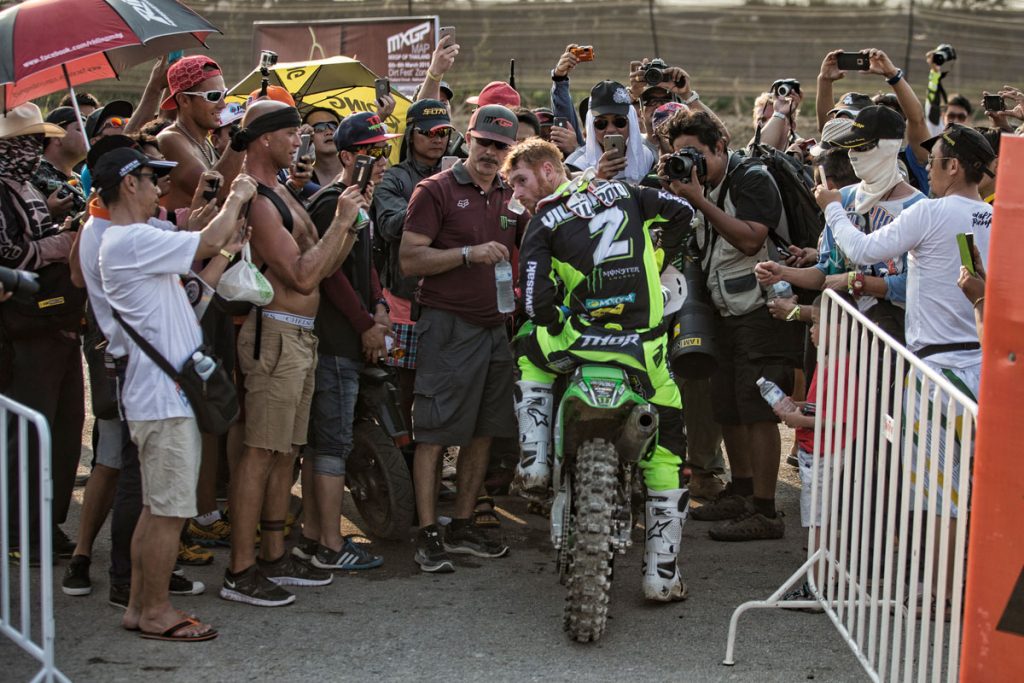
Villopoto’s final blazer
Such was AMA Supercross and Motocross legend Ryan Villopoto’s pace through the Qualification Heat within the impossibly-hot confines of the Nakhonchaisri circuit for the 2015 Grand Prix of Thailand and round two of the MXGP FIM World Championship, that the 26 year old Kawasaki Racing Team rider was asked if he might potentially make the premier class “boring”. Villopoto creamed the opposition around the rough-edged man-made layout to win by over 30 seconds; but those same riders were puzzled as to why the GP ‘rookie’ was pounding the laps in a Qualification dash.
On Sunday Villopoto caused another small tremor in MXGP by going 1-3 and winning the event; adding another small distinction to one of the best CVs in the sport. The expected domination did not arrive, however. He was 4-4 in Argentina, and then infamously looped out of the Grand Prix of Trentino – the condensed, scratchy hard-pack Pietramurata circuit a quintessential Italian GP venue and ‘another world’ for the American – whereupon a broken tailbone dissolved the career of one of the true greats.
For a period of months MXGP had been hit by what KRT called ‘the Villopoto effect’. Rarely had the series basked in such hype, and the zeal of a prospective clash between the AMA Champion and six-times title winner Tony Cairoli. Ironically his Grand Prix debut at the Grand Prix of Qatar came in front of the smallest crowd of the season…but must have given the series its largest TV/online surge in years. Villopoto was mobbed in Thailand and Argentina – Neuquen has not seen a crowd like 2015 since – to the point where he needed his own security detail. If anything, his presence confirmed the international appeal of both the sport and supercross: if promoters could somehow combine championships, stars and disciplines then they would have a major, major show on their hands.
As a small aside, Nakhonchaisri produced one of the strangest occurrences. Temperatures were in the mid-30s with suffocating air. At the end of the first MX2 moto both Jeremy Seewer and reigning world champion Jordi Tixier crashed less than fifty metres from the chequered flag and across a low ski-jump into the short straight to the table-top. Neither rider could pick up their bikes and contemplate the short walk to the finish line. Seewer, who had been 6th, groggily walked and collapsed to the side of the track, almost under the race steward signalling the end of the race, while Tixier was taken to the medical centre for treatment of heat exhaustion. His aggressive response to doctors when he was not allowed to participate in the second moto led to an FIM fine and he sat-out the following Grand Prix of Argentina.
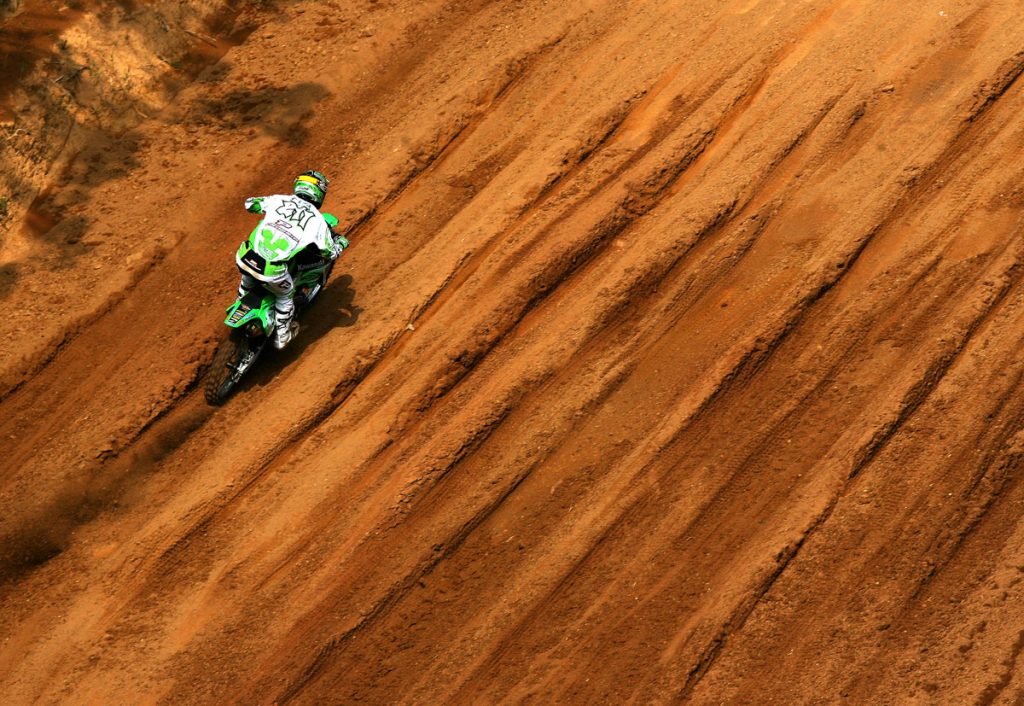
Mackenzie’s Sugo spell
The FIM Motocross World Championship travelled to Japan and the Sugo circuit between 2005-2007. The Grand Prix was an eagerly anticipated trip for the series. Sugo, close to the city of Sendai, was humble and small and would probably be deemed inadequate for a European fixture dealing with far more people and infrastructure. The Japanese factories brought their set-ups normally reserved for the All-Japan Championship and usually with the latest trick parts and ideas on the wild-card machines – sometimes for the bikes of the Grand Prix riders. It meant a walk around the paddock was essential for the eagle-eyed and technical minded. Away from the venue and the Sendai electronic stores were the best place to find racers and their crews, eager to capitalise on the latest gadgets for favourable prices. The handful of Italian restaurants in the city did a roaring trade for four days.
Sugo itself was a spectacular track, distinctive for its loose and loamy soil that bred lines like no tomorrow. Crowd presence would dwindle by the last edition in 2007 but generally the enthusiasm of the public, the novelty of the setting (heat, humidity, rice fields all around, extravagant opening ceremonies) and the chance to race across the Japanese terrain that was somehow different to anything else found on the calendar meant the Grand Prix was briefly an annual highlight in the midst of the schedule.
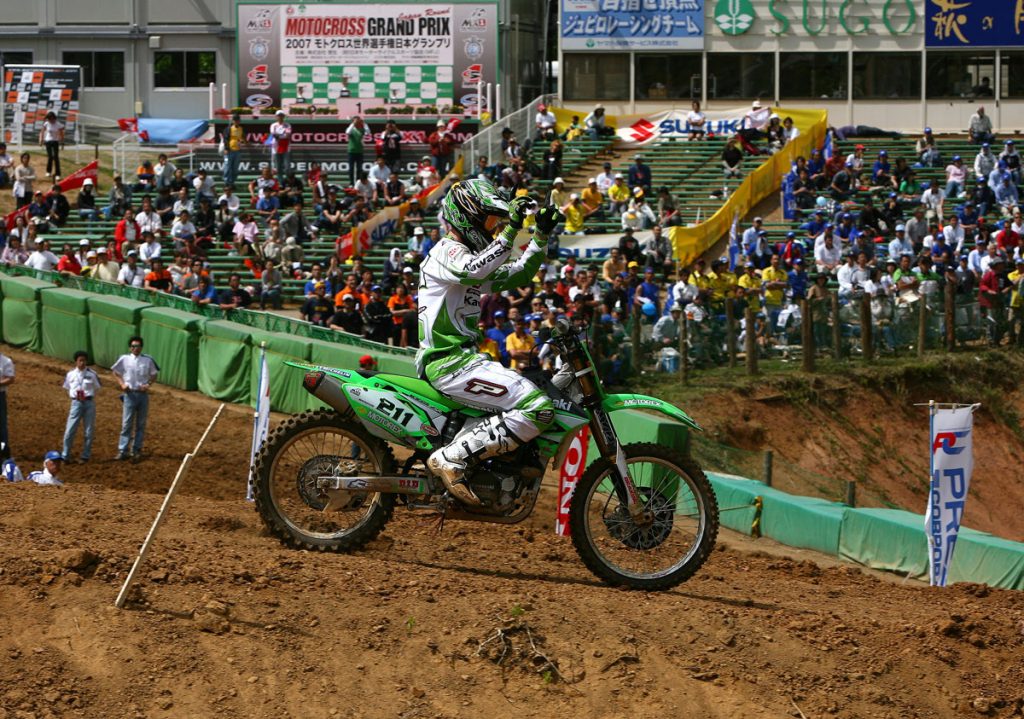
Although the FIM World Championship is no stranger to winning streaks at a particular venue (both Tony Cairoli and Jeffrey Herlings have long ties with the Grand Prix at Valkenswaard) the bond that Scottish racer Billy Mackenzie forged with Sugo is baffling. A complex, outward, rebellious and individual competitor, Mackenzie celebrated his first career win riding Steve Dixon’s Yamaha in Japan in 2005. Somehow a relaxed and nonchalant approach to the meeting (Mackenzie enjoyed raiding the downtown McDonalds while dealing with his jetlag and was photographed lying in the start gate contemplating the first turn) paid-off again in 2006. By the time he was a factory Kawasaki rider in MX1 in 2007 and raced to the team’s first win, the first for the KX450F that had been in development for three years (and the last for the ailing Jan de Groot who would pass away that summer) as well as the first for Great Britain in the premier class, I recall French journalist Pascal Haudiquert shaking his head at how Mackenzie could always be so brilliant at Sugo and then infuriatingly hit-and-miss back in Europe.
The 23-year old was a creature of habit. “The first time I won here I was listening to ‘Insomnia’ by Faithless on my mp3 player and as we came to the start – I was not in the spotlight back then – I laid down at the back of the gate watching all the other riders,” he divulged. “I won that day for the first time, so every season we have been back I have done the same. Yellow has been my lucky colour here, so Smith kindly sent me some bright goggles. That’s the routine and while it works I won’t change it. I can always say that I have won a GP in MX1 and MX2 now. I am racing against the best in the world here and to come out on top was awesome.”
Sadly, a factory Honda ride in 2008 was dented by a broken thumb ligament. Mackenzie never won another Grand Prix and the FIM World Championship has yet to return to Japan.
To see and read more then click HERE to go to the free, easy-to-read latest issue of OTOR magazine
By Adam Wheeler
Photos by Ray Archer @rayarcherphoto


